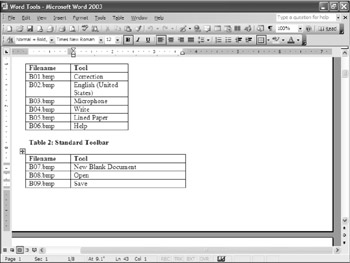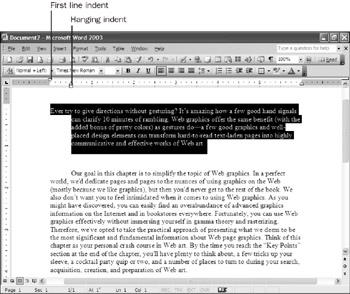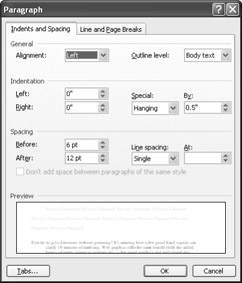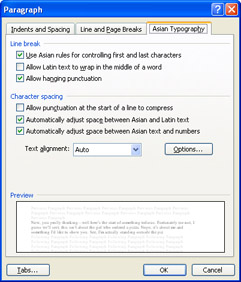Formatting Paragraphs by Aligning and Indenting Text
|
| < Day Day Up > |
|
One of the most common paragraph formatting tasks is aligning paragraphs within a document. As you know, you can set margins to specify overall page and document alignment. But alignment matters don't stop there. You can also control alignment at the paragraph level by specifying text alignment and indentation. You can configure paragraph alignment settings using these familiar methods:
-
Click buttons on the Formatting toolbar or press keyboard shortcuts to quickly format paragraphs.
-
Use the horizontal ruler to align paragraphs visually.
-
Configure settings in the Paragraph dialog box.
This portion of the chapter examines the intricacies of each of these techniques.
| Cross-Reference | For more information about setting margins and configuring overall page setup parameters, see Chapter 15, "Mastering Page Setup and Pagination." |
Aligning Paragraphs Using Toolbar Buttons and Keyboard Shortcuts
The quickest way to apply paragraph formatting is to click within a paragraph or select a few paragraphs, and then click a button on the Formatting toolbar or press a keyboard shortcut. Of course, these processes are limited by their default settings, but in many cases, the easiest route proves to be the best when it comes to paragraph formatting. To review which Formatting buttons and keyboard shortcuts can help you format paragraphs, see Table 8-1.
| Format | Toolbar Button | Keyboard Shortcut | Description |
|---|---|---|---|
| Align Left | | Ctrl+L | Aligns information along the left margin of the page or specified area, with a ragged right edge. |
| Align Center | | Ctrl+E | Aligns the midpoint of each line with the horizontal center of the page or area. |
| Align Right | | Ctrl+R | Aligns information along the right margin of the page or specified area, with a ragged left edge. |
| Justify | | Ctrl+J | Aligns text flush with both the left and right margins of the page or specified area. |
| Line Spacing | | Ctrl+1 (single-space), Ctrl+2 (double-space), or Ctrl+5 (1.5-space) | Controls the vertical spacing between lines of text. Clicking the Line Spacing arrow displays a list of line spacing options. |
| Decrease Indent | | Ctrl+Shift+M | Decreases a paragraph's indent by one tab stop. By default, tab stops are set every 0.5 inch. |
| Increase Indent | | Ctrl+M | Increases a paragraph's indent by one tab stop. By default, tab stops are set every 0.5 inch. |
| Border | | None | Applies a border to specified text. Clicking the Borders arrow displays a menu of common border options. |
Aligning Paragraphs Using the Ruler
Formatting toolbar buttons and keyboard shortcuts give you quick access to paragraph formatting options, but the Word ruler offers visually oriented people an intuitive and more precise method for controlling paragraph alignment as well as providing a greater variety of alignment settings. The trick to using the ruler effectively is to become comfortable with the ruler's markers. To get up to speed, look at Figure 8-2, which shows the Word 2003 ruler (which looks extremely similar to the ruler in earlier versions of Word). The next few sections describe how to use the ruler markers to format paragraphs.

Figure 8-2: You can use the Word ruler to quickly and accurately align document content.
Displaying and Configuring the Ruler
By default, Word displays the ruler in Normal, Web Layout, and Print Layout views and does not display the ruler in Outline and Reading Layout views. If you don't see the ruler in Normal, Web Layout, or Print Layout view, you can display it by choosing View, Ruler.
| Tip | To control whether the vertical ruler appears in Print Layout view, you must configure the View tab in the Options dialog box. To do so, choose Tools, Options, click the View tab, and then select or clear the Vertical Ruler (Print View Only) check box, in the Print And Web Layout Options section. Note that the vertical ruler isn't available in other Word views. |
As you can see in Figure 8-2, the 0 (zero) spot on the ruler corresponds to the left margin setting. By default, the left and right margins are set to 1.25 inches on 8.5-by-11-inch paper. Thus, the default setup provides 6 inches between the margins for content.
You've probably noticed that the ruler measurements are shown in inches. If you prefer to use other units of measurement, you can change the default measurement unit setting as follows:
-
Choose Tools, Options, and click the General tab.
-
In the General tab, click the Measurement Units arrow, select a measurement unit in the list, and click OK. Available options are Inches, Centimeters, Millimeters, Points, and Picas.
Adjusting Left and Right Indents
To adjust left and right indents using the ruler, click within the paragraph (even if it's an empty paragraph) or select the paragraphs you want to adjust, or select the entire document (press Ctrl+A). Then click and drag the Left Indent or Right Indent marker on the ruler.
| Tip | To move the First Line Indent marker along with the Hanging Indent marker, drag the small rectangle below the Hanging Indent marker (the Left Indent marker) on the ruler. Dragging the Left Indent marker retains the relative settings of the first line and left margin. |
When you're working with tables, the ruler offers additional alignment markers, as shown in Figure 8-3. Namely, you can drag column markers to alter margin widths and row height markers to adjust row height; the margin markers move to correspond to the currently selected row and column. You can also indent table cell contents or entire columns.

Figure 8-3: When you're working with tables in Print Layout view, you can use the vertical and horizontal rulers to adjust row heights and column widths.
| Cross-Reference | For more information about resizing and aligning tables and table contents, see Chapter 13, "Organizing Concepts in Tables." |
Creating First Line and Hanging Indents
You can use the ruler to create a hanging indent or a first-line indent, as illustrated in Figure 8-4. To do so, click in the paragraph you want to format or select multiple paragraphs, and then drag the First Line Indent marker left or right to the desired location.

Figure 8-4: You can drag the First Line Indent marker to create a hanging indent or a first-line indent.
| Tip | You can press Ctrl+T to create a hanging indent that aligns body text with the first tab marker. (By default, tabs are set every 0.5 inch.) You can press Ctrl+Shift+T to "unhang" an indent, regardless of how the hanging indent was created. |
Aligning Paragraphs Using the Paragraph Dialog Box
Using toolbar buttons, keyboard shortcuts, and ruler markers to align paragraphs can be quick, but aligning paragraphs by using the Paragraph dialog box offers its own advantages. By configuring settings in the Paragraph dialog box, you can align paragraphs precisely as well as apply a number of paragraph formatting settings at one time.
To display the Paragraph dialog box, shown in Figure 8-5, choose Format, Paragraph, or right-click a paragraph (or selected paragraphs), and choose Paragraph from the shortcut menu.

Figure 8-5: The Paragraph dialog box provides precise and complete control of paragraph formatting.
| Tip | You can also display the Paragraph dialog box by clicking the Alignment, Indentation, or Spacing link in the Reveal Formatting task pane, as described in "Modifying Paragraph Attributes Using Reveal Formatting,". |
The Indents And Spacing tab offers the following paragraph alignment options:
-
Alignment Sets the position of paragraph contents relative to the margins. Available alignment options are Left, Centered, Right, and Justified. The options in this list correspond to the alignment buttons on the Formatting toolbar.
-
Left Indentation Indents the paragraph from the left margin by the amount you specify. To display text or graphics within the left margin, enter a negative number in the Left box.
-
Right Indentation Indents the paragraph from the right margin by the amount you specify. To display text or graphics within the right margin, enter a negative number in the Right box.
-
Special and By Controls the paragraph's first-line indentation. The Special list box has three options: (None), First Line, and Hanging. The (None) option is selected by default. To specify the first-line indent, enter a value in the By box; the Special list box changes to display First Line automatically.
You can configure other paragraph settings in the Paragraph dialog box, including paragraph spacing parameters, as you'll see next.
If you have additional languages enabled for Office (which is achieved by selecting Start, All Programs, Microsoft Office, Microsoft Office Tools, Microsoft Office 2003 Language Settings), you might see an additional tab in the Paragraph dialog box that contains paragraph options relevant to the particular language. For example, the following graphic shows the Asian Typography tab, which appears when Japanese is enabled in an English (US) version of Office:

For more information about working with language features in Word, see Appendix B, "Implementing Multilanguage Features."
|
| < Day Day Up > |
|
EAN: 2147483647
Pages: 373